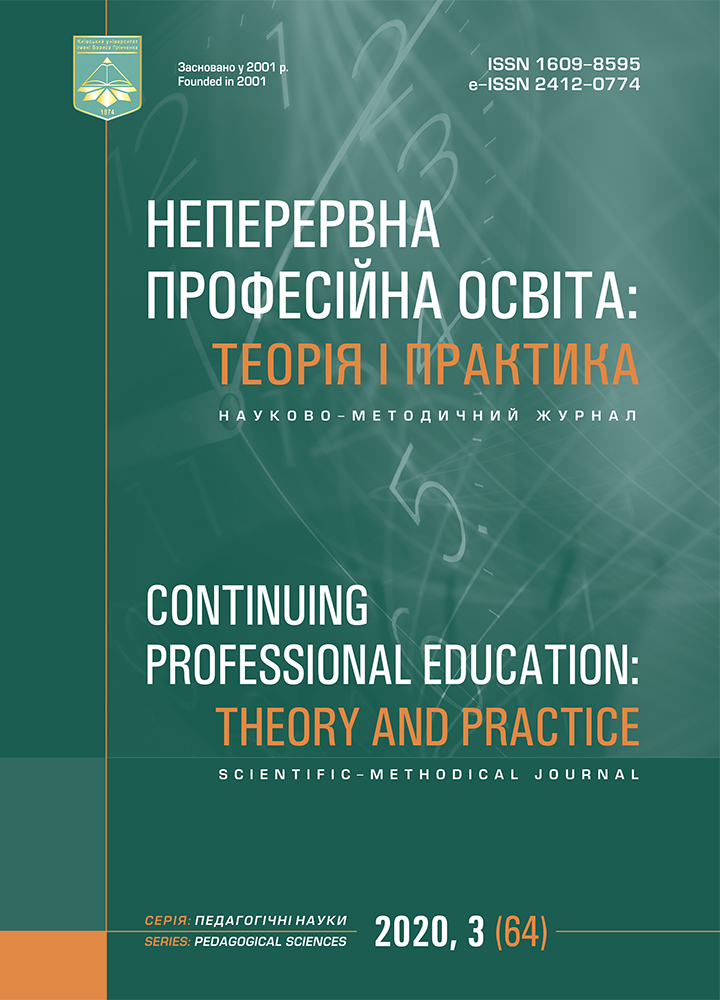APPLICATION OF THE INTERDISCIPLINARY RELATIONS FOR HIGHER EDUCATION QUALITY ASSURANCE
DOI:
https://doi.org/10.28925/1609-8595.2020.3.12Keywords:
competencies, interdisciplinary programs, interdisciplinary approach, subject-language integrated learning, independent cognitive activity of students, quality of higher educationAbstract
The article highlights the issue of ensuring the quality of higher education through the prism of the use of interdisciplinary links on the example of the study of historical disciplines and foreign languages. The analysis of the legal framework, as well as the scientific literature made it possible to identify effective ways to ensure the quality of higher education.
One of them is the application of the principles of interdisciplinary relations. The implementation of the interdisciplinary approach is considered as a promising method for the professional training of students of the Faculty of History with the use of knowledge of a foreign language.
It is proposed to create integrated programs, teaching professional disciplines in English. It is recommended to offer students English literature
In the context of the interdisciplinary approach, the integration of professional components using the skills of linguistic literacy is considered.
The concept of interdisciplinary research is based on the premise that concepts and facts are not studied in isolation from each other. Implementation of the disciplinary approach is considered as a promising method for professional training of students for the application of knowledge in other disciplines.
The European vector of higher education development is determined by the high level of requirements for the specialist, which necessitates the search for effective ways to ensure the quality of higher education. One of the directions of updating the learning process is the integration of educational material from different disciplines, namely: historical disciplines and foreign language.
To apply the principle of interdisciplinary links, it is important to use the CLIL approach in foreign language classes.
The teaching of professional disciplines in English is relevant today in domestic universities, as it is an important factor in increasing prestige, internationalization and improving the quality of professional training.
When creating integrated programs to enhance the independent cognitive activity of students of the Faculty of History, it is important to recommend students to English-language literature.
The use of interdisciplinary connections allows students of the Faculty of History to discover their creative potential and develop as a person.
References
Debych, M. A. (2014). Optimizaciya ciklu suspilnih ta gumanitarnih disciplin u vishij osviti: mizhnarodnij dosvid [Optimization of the cycle of social sciences and humanities in higher education: international experience]. In B. A. Voronkova, M. A. Debych, N. M. Demianenko, N. O. Divinska ta in.; H. V. Onkovych (Ed.), Optimization of the cycle of social and humanitarian disciplines in higher education of Ukraine in the context of European integration: monograph (p. 21–32). Institute of Higher Education of the NAES of Ukraine.
Nikolaieva, S. Iu. (Ed.) (2003). Zahalnoievropeiski rekomendatsii z movnoi osvity: vyvchennia, vykladannia, otsiniuvannia [Common European Framework of Reference for Languages: Learning, Teaching, Assessment]. Lenvit.
Zakon Ukrainy «Pro vyshchu osvitu» [Law of Ukraine On Higher Education]. http://zakon0.rada.gov.ua/laws/ show/1556-18.
Paris-Communiqué-(2018).-https://mon.gov.ua/storage/app/media/news/Novyny/2018/06/06/12/paris-communiqueenua2018.pdf
Robocha prohrama navchalnoi dystsypliny «Nova istoriia krain Yevropy ta Ameryky» [Working program of the discipline «New History of Europe and America»] (2019). Mykolaivskyi natsionalnyi universytet im.V. O. Sukhomlynskoho.
Sysoieva, S., Kozak, L. (2017). Osoblyvosti navchannia bakalavriv u providnykh krainakh svitu [Features of studies of bachelors in leading countries of the world]. Continuing Professional Education: Theory and Practice, 1–2 (50–51), 99–109. https://doi.org/10.28925/1609-8595.2017(1-2)99109
Sova, M. O. (2009). Kontseptualna model intehrovanoho navchannia i tekhnolohiia yii vprovadzhennia u navchalnyi protses vyshchoi shkoly [Conceptual model of integrated learning and technology of its introduction into the educational process of higher education]. Bioresursy i pryrodokorystuvannia : Naukovyi zhurnal, 1 (1/2), 169–177.
Shevchuk, K. (2007). Intehrovanyi pidkhid do navchannia: retrospektyvnyi analiz [An integrated approach to learning: a retrospective analysis]. Naukovi zapysky Vinnytskoho derzhavnoho pedahohichnoho universytetu imeni Mykhaila Kotsiubynskoho. Seria Pedahohika i psykholohiia, 20, 50–55.
Barry, A., Born, G., Weszkalnys, G. (2008). Logics of interdisciplinarity. Economy and Society, 37 (1), 20–49. https:// doi.org/10.1080/03085140701760841
Bolitho, R., West, R. (2017). The internationalisation of Ukrainian universities: the English language dimension. Stal.
Drake, S. M., Burns, R. C. (2004). Meeting Standards Through Integrated Curriculum. Association for Supervision and Curriculum Development.
Grytsyk, N. (2016). Соntent and language integrated learning: approach to teaching English for specific purposes. Nauka i osvita, 12, 22–28.
Li, Y. (2020). Language-content partnership in higher education: development and opportunities. Higher Education Research and Development, 39 (3), 500–514. 10.1080/07294360.2019.1685947
Salvador-García, C., Capella-Peris, C., Chiva-Bartoll, O., Ruiz-Montero, P. J. (2020). A Mixed Methods Study to Examine the Influence of CLIL on Physical Education Lessons: Analysis of Social Interactions and Physical Activity Levels. Frontiers in Psychology, 11. 10.3389/fpsyg.2020.00578
Wallin, P. (2020). Student perspectives on co-creating timescapes in interdisciplinary projects. Teaching in Higher Education, 25 (6), 766–781. 10.1080/13562517.2020.1777962
Zaskaleta, S. (2019). Implementation of principles of interdisciplinary links in professional training in EU countries. Continuing Professional Education: Theory and Practice, 1 (58), 68–72. https://doi.org/10.28925/1609-8595.2019.1.6872
Downloads
Published
How to Cite
Issue
Section
License
Copyright (c) 2020 Svitlana Zaskaleta, Natalia Buglay

This work is licensed under a Creative Commons Attribution-NonCommercial 3.0 Unported License.



